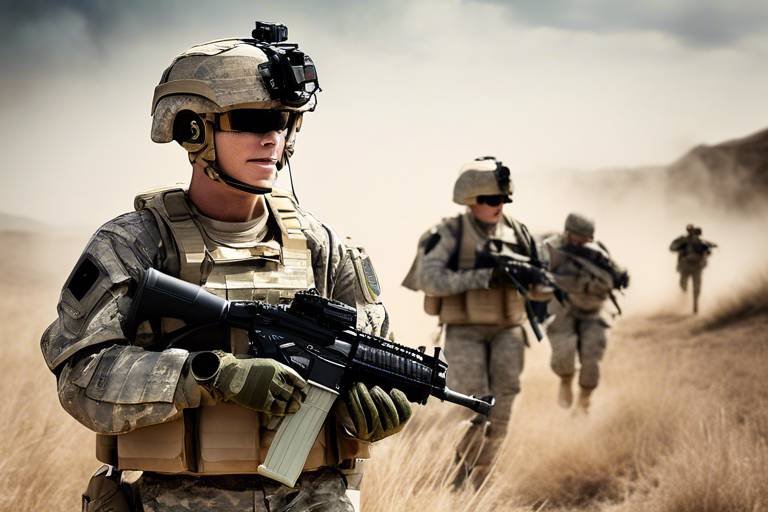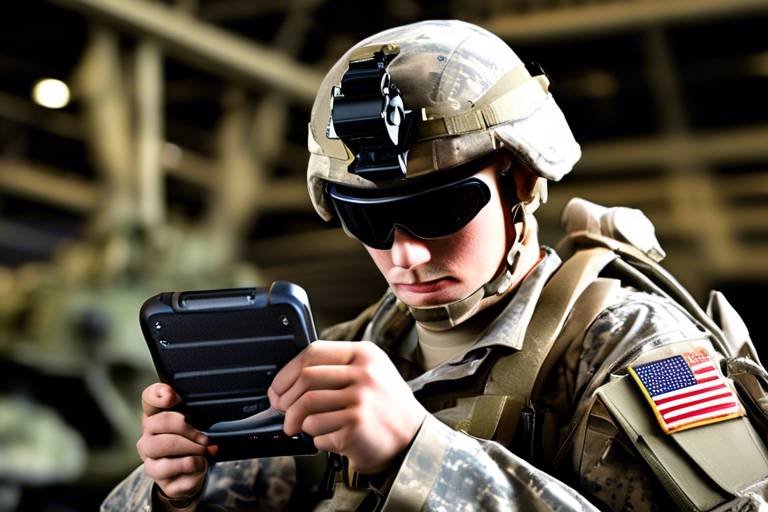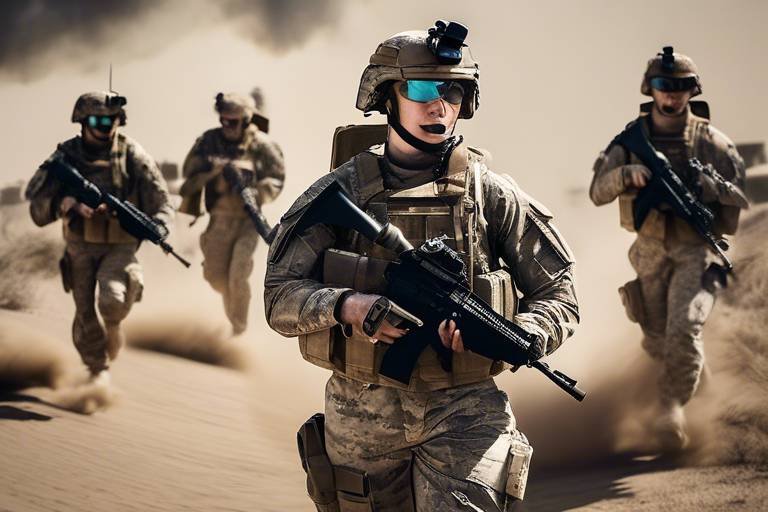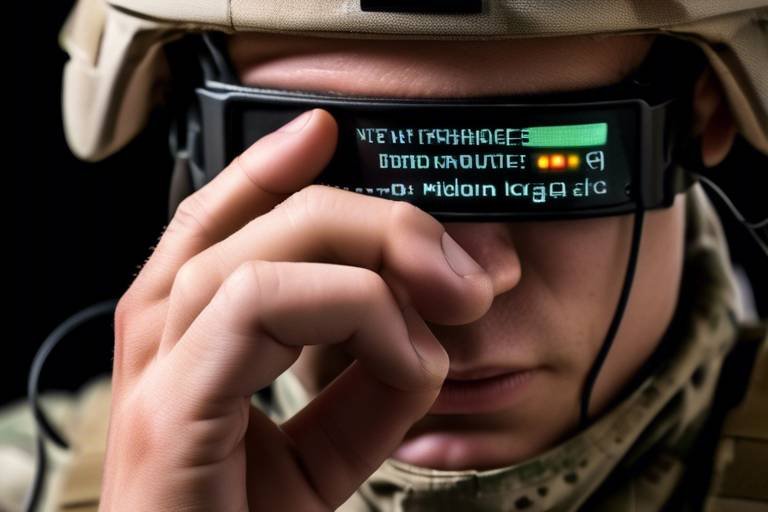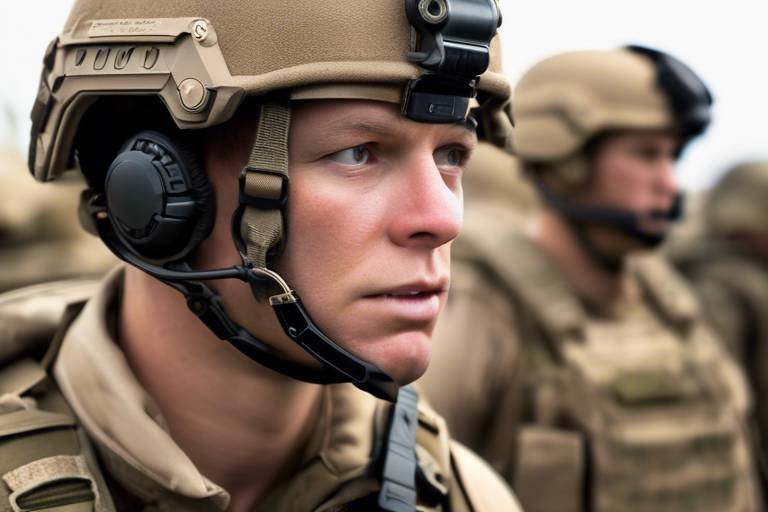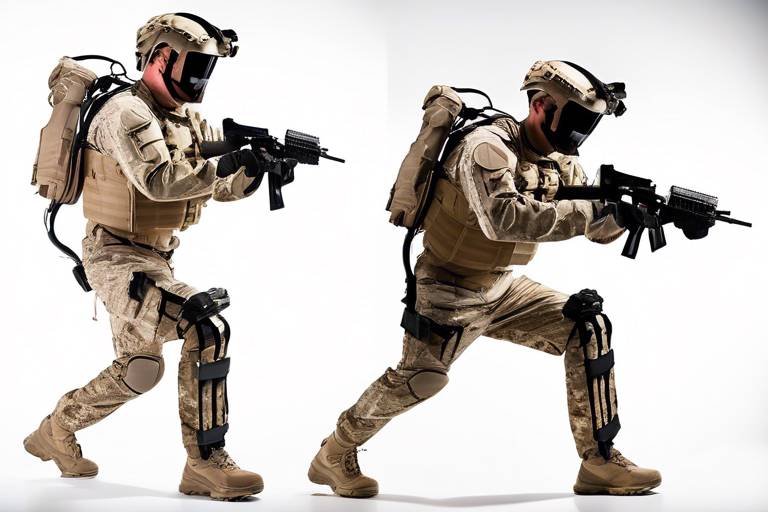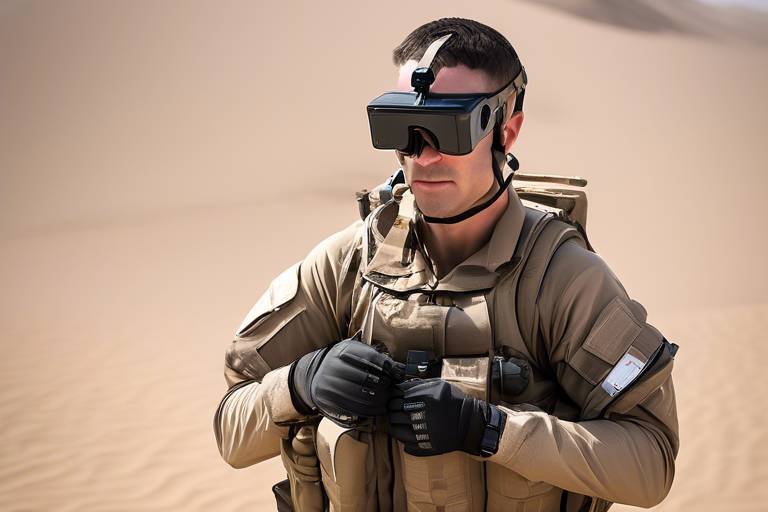How Wearables Support Tactical Decision-Making in High-Stress Environments
In today's fast-paced world, the integration of technology into our daily lives is nothing short of revolutionary. But when we talk about high-pressure scenarios, like those faced by tactical teams, the stakes are even higher. Imagine being in a tense situation where every second counts. This is where wearable technology steps in, acting as a lifeline that enhances decision-making processes. These devices are not just gadgets; they are essential tools that provide critical insights, improve situational awareness, and ultimately save lives.
Wearable devices, from smart glasses to biometric monitors, play a pivotal role in tactical operations. By providing real-time data, these technologies enable teams to make informed decisions on the fly. Think of wearables as a tactical partner that never sleeps, constantly analyzing and delivering vital information. This integration of technology into tactical operations leads to better outcomes, allowing teams to respond swiftly and effectively to evolving situations. For instance, during a high-stakes mission, a wearable device might alert a team member to a sudden change in environmental conditions, allowing them to adjust their strategy accordingly.
The essence of effective decision-making in high-stress environments lies in real-time data collection and analytics. Wearables excel in this area, capturing data that can influence tactical strategies almost instantaneously. Imagine a scenario where a team is engaged in a critical operation, and a wearable device detects a sudden spike in heart rates among team members. This information can trigger an immediate reassessment of the situation, helping leaders determine whether to proceed or withdraw. The ability to access timely information can mean the difference between success and failure.
When we delve into the world of wearables used in tactical environments, we encounter a variety of devices designed for specific functions. Here are some prominent examples:
- Smart Glasses: These devices offer augmented reality capabilities, displaying critical information directly in the user’s line of sight.
- Biometric Monitors: These track physiological parameters such as heart rate and stress levels, providing insights into the health and readiness of team members.
- GPS Trackers: These ensure that team members are aware of each other's locations, enhancing coordination during operations.
Smart glasses are a game-changer in tactical situations. They allow users to access critical information hands-free, thereby enhancing situational awareness. Imagine being able to see maps, enemy positions, or mission objectives without taking your eyes off the action. This capability not only boosts confidence but also allows for quicker decision-making. In high-stress environments, where distractions can be deadly, smart glasses provide a seamless way to stay informed while remaining focused on the task at hand.
Biometric monitors serve as vital indicators of a team member's physical state. By tracking parameters such as heart rate, temperature, and even hydration levels, these devices offer insights that can inform tactical decisions. For instance, if a monitor detects elevated stress levels, a leader might choose to pause operations to regroup and reassess. This proactive approach can prevent exhaustion and improve overall team performance, ensuring that every member is at their best when it counts the most.
One of the most significant advantages of wearable technology is its ability to integrate seamlessly with communication systems. This connectivity enhances coordination among team members, ensuring that everyone is on the same page. Imagine a scenario where a team is spread out over a large area. With wearables, they can share real-time updates, coordinate movements, and respond to threats more effectively. This level of communication is crucial in tactical operations, where miscommunication can lead to dire consequences.
The adoption of wearable technology in tactical environments comes with a plethora of benefits that extend beyond mere convenience. Here are some key advantages:
Wearables streamline workflows and reduce response times, leading to more efficient operations. With instant access to vital information, teams can make quicker decisions, which is essential in high-stakes situations. For example, during a rescue mission, the ability to quickly assess the health and location of team members can significantly impact the outcome. Efficiency achieved through technology is not just about speed; it's about making informed choices that enhance the overall success of the mission.
In high-stress environments, safety is paramount. Wearables contribute to better safety protocols and risk management during operations. By providing real-time health data and environmental alerts, these devices help teams navigate dangerous situations more effectively. For instance, if a wearable detects a drop in a team member's oxygen levels, it can prompt an immediate response, potentially preventing a life-threatening situation. The proactive nature of wearables in ensuring safety cannot be overstated.
Q: How do wearables enhance decision-making in tactical operations?
A: Wearables provide real-time data and analytics, allowing teams to make informed decisions quickly, which is crucial in high-pressure situations.
Q: What types of wearable technologies are commonly used in tactical environments?
A: Common wearable technologies include smart glasses, biometric monitors, and GPS trackers, each serving specific functions to enhance operational effectiveness.
Q: How do biometric monitors contribute to team safety?
A: Biometric monitors track health metrics such as heart rate and stress levels, providing insights that can inform tactical decisions and enhance team safety.
The Role of Wearables in Tactical Situations
In the fast-paced world of tactical operations, every second counts. Imagine being in a high-stress environment where the stakes are incredibly high. This is where wearable technology steps in, acting like a silent partner that enhances decision-making processes. These devices are not just trendy gadgets; they are crucial tools that provide critical data and insights, allowing operators to make informed decisions swiftly. The integration of wearables into tactical situations can significantly improve situational awareness, which is essential for effective decision-making.
Wearable devices, such as smart glasses and biometric monitors, serve as an extension of the operator’s senses. They gather and display data in real-time, ensuring that team members have access to the information they need when they need it most. For instance, smart glasses can overlay vital statistics and mission-critical information directly into the user’s field of vision, allowing them to maintain focus on their surroundings while accessing essential data. This capability is akin to having a personal assistant who whispers crucial insights into your ear while you navigate a complex environment.
The integration of wearables into tactical operations is not just about the technology itself; it’s about how these devices can transform the way teams operate. By providing real-time analytics and situational updates, wearables help in identifying potential threats and opportunities that may not be immediately visible. Consider the following functionalities that wearables bring to the table:
- Enhanced Situational Awareness: Wearables provide operators with a comprehensive view of their environment, helping them to anticipate challenges.
- Rapid Data Processing: With the ability to analyze data on the fly, decisions can be made faster, which is crucial in high-pressure situations.
- Improved Coordination: When every team member is equipped with wearables, communication becomes seamless, allowing for better teamwork and strategy execution.
In essence, the role of wearables in tactical situations is to bridge the gap between human capability and technological advancement. They empower individuals to act decisively and effectively, even when faced with overwhelming stress and uncertainty. As the landscape of tactical operations continues to evolve, the reliance on wearable technology will likely increase, making it an indispensable part of modern operational strategy.
Real-Time Data and Analytics
In today's fast-paced world, particularly in high-stress environments, the ability to make quick and informed decisions can mean the difference between success and failure. This is where the power of comes into play. Wearable technology is not just a trendy accessory; it serves as a lifeline, providing critical insights that can enhance tactical strategies in the heat of the moment. Imagine being in a high-stakes situation where every second counts. With wearables, you have immediate access to vital information, allowing you to respond swiftly and effectively.
Wearable devices equipped with sensors can collect a wide array of data, from physiological metrics like heart rate and body temperature to environmental factors such as air quality and noise levels. This data is then analyzed in real-time, offering a comprehensive view of the situation at hand. For instance, if a team member's heart rate spikes, it could indicate a rise in stress, prompting immediate intervention. This kind of timely information can drastically influence tactical strategies, ensuring that teams are not only reacting to the present but also anticipating potential challenges.
Moreover, the integration of advanced analytics allows teams to identify patterns and trends that might not be immediately visible. For example, by analyzing historical data alongside real-time metrics, decision-makers can pinpoint which strategies have worked in similar situations before. This predictive capability can significantly enhance operational effectiveness, allowing teams to stay one step ahead of the game. It's like having a tactical crystal ball that helps you foresee challenges and adapt your approach accordingly.
To illustrate the impact of real-time data and analytics, consider the following table that outlines various metrics collected by wearable devices and their implications for tactical decision-making:
| Metric | Implication |
|---|---|
| Heart Rate | Indicates stress levels and physical exertion, helping to assess team readiness. |
| Body Temperature | Can signal potential health issues or environmental stressors. |
| Location Data | Provides real-time positioning of team members, enhancing coordination. |
| Environmental Conditions | Alerts teams to hazardous conditions, enabling preemptive actions. |
In conclusion, the role of real-time data and analytics in tactical environments cannot be overstated. Wearable technology not only enhances situational awareness but also empowers teams to make data-driven decisions swiftly. As we continue to integrate these technologies into our operations, the potential for improved outcomes in high-stress situations grows exponentially. By leveraging real-time insights, tactical teams can navigate challenges with greater confidence and effectiveness.
- What types of data can wearables collect? Wearables can collect various data types, including physiological metrics (like heart rate and temperature), location data, and environmental conditions.
- How do wearables improve decision-making? By providing real-time insights, wearables enable teams to respond quickly and adapt their strategies based on current conditions.
- Are wearables reliable in high-stress environments? Yes, when properly utilized, wearables can provide critical information that enhances situational awareness and operational efficiency.
Types of Wearable Technologies
When we talk about wearable technologies, it's like stepping into the future where gadgets are not just accessories but essential tools that aid in decision-making, especially in tactical environments. These devices come in various forms, each designed to serve specific functions that enhance operational efficiency and situational awareness. The most prominent types of wearable technologies include smart glasses, biometric monitors, and smartwatches.
Smart glasses are a game-changer in tactical settings. Imagine being in a high-pressure situation where you need to access critical information without taking your hands off your equipment. Smart glasses provide augmented reality capabilities, overlaying essential data directly into your line of sight. This means that while you’re navigating through a complex environment, you can simultaneously view maps, receive real-time updates, or even communicate with your team—all without breaking your focus. The ability to see and interact with information in real-time can significantly enhance situational awareness, allowing for quicker and more informed decisions.
On the other hand, biometric monitors offer a different but equally important function. These devices track various physiological parameters such as heart rate, body temperature, and even stress levels. In the heat of the moment, understanding your body’s response can be crucial. For instance, if a tactical operator's heart rate spikes, it could indicate an elevated stress level, which may affect their decision-making ability. By having access to this data, commanders can make informed decisions about personnel deployment and manage team dynamics more effectively.
Another noteworthy technology is the smartwatch, which, while often seen as a fitness accessory, can be tailored for tactical use. Equipped with GPS, communication capabilities, and health tracking features, smartwatches can serve as a central hub for information dissemination. They can alert users to important notifications, track location, and even facilitate communication with team members. This integration of functionalities makes smartwatches versatile tools in high-stress scenarios.
In addition to these primary devices, there are also wearable sensors that can be attached to uniforms or gear. These sensors collect environmental data, such as temperature and humidity, which can be crucial in certain tactical operations. For instance, knowing the environmental conditions can help teams adapt their strategies to ensure optimal performance.
To summarize, the landscape of wearable technologies in tactical environments is diverse and continually evolving. Each type of device plays a pivotal role in enhancing not just individual performance but also overall team effectiveness. By integrating these technologies into tactical operations, decision-makers can leverage real-time data and insights that ultimately lead to better outcomes.
Smart Glasses for Enhanced Vision
In today's fast-paced tactical environments, having the right information at your fingertips can make all the difference between success and failure. Smart glasses are revolutionizing how tactical teams operate by providing enhanced vision capabilities that integrate seamlessly with real-time data feeds. Imagine being in a high-pressure situation where every second counts; having access to critical information without taking your eyes off the action is invaluable.
These cutting-edge devices not only allow users to see their surroundings but also overlay vital data directly onto their field of vision. This augmented reality functionality means that tactical operators can receive live updates about their environment, including enemy locations, weather conditions, and mission objectives. With smart glasses, the need to glance down at a handheld device is eliminated, allowing for a more immersive and focused experience.
One of the key advantages of smart glasses is their ability to provide hands-free access to information. For instance, a soldier on the ground can receive real-time intelligence updates while maintaining full situational awareness. This can be crucial in high-stress scenarios, where distractions can lead to mistakes. Furthermore, smart glasses can be equipped with voice recognition technology, enabling users to issue commands or request information without interrupting their workflow.
Additionally, smart glasses can facilitate improved communication among team members. With built-in cameras and microphones, users can share visual information instantly, enabling better coordination during operations. This feature is particularly useful in complex environments where visual cues play a critical role in decision-making. Imagine a tactical team operating in a dense urban area; the ability to share what one member sees with the rest of the team can significantly enhance situational awareness and strategy formulation.
Despite their many benefits, the integration of smart glasses into tactical operations is not without challenges. Issues such as battery life, durability, and data security are crucial considerations. However, advancements in technology are continually addressing these concerns, making smart glasses a more reliable option for tactical teams. As these devices become more robust and user-friendly, their adoption in high-stress environments will likely increase, paving the way for even more innovative applications.
In conclusion, smart glasses represent a significant leap forward in tactical decision-making. By providing enhanced vision and real-time data integration, they empower users to make informed decisions quickly and effectively. As we move forward, the potential for smart glasses in tactical operations is boundless, offering a glimpse into a future where technology and human capability merge seamlessly.
Biometric Monitors for Health Insights
In the realm of tactical decision-making, biometric monitors play a pivotal role by providing real-time insights into the physiological states of personnel. These devices are more than just gadgets; they act as a window into the body’s response to stress, fatigue, and overall readiness. Imagine being in a high-pressure situation where every second counts. The ability to monitor heart rates, stress levels, and other vital signs can be the difference between success and failure.
Biometric monitors are equipped with advanced sensors that track a variety of health metrics, which can be crucial during tactical operations. For instance, a sudden spike in heart rate might indicate heightened stress or impending physical exertion, prompting leaders to adjust strategies on the fly. This real-time feedback allows teams to make informed decisions based on the current physical state of their members, ensuring that no one is pushed beyond their limits. The integration of these monitors into tactical gear transforms how teams operate, making them more agile and responsive.
Consider the following key metrics that biometric monitors typically track:
- Heart Rate: Indicates stress levels and physical exertion.
- Body Temperature: Helps assess the physical condition and potential heat-related issues.
- Respiration Rate: Provides insights into the individual's stress and anxiety levels.
- Oxygen Saturation: Essential for determining readiness and performance, especially in high-altitude operations.
By analyzing these metrics, tactical teams can implement effective strategies tailored to their personnel's current health status. For example, if a team member's biometric data indicates extreme fatigue, it might be wise to rotate duties or provide a brief recovery period. This not only enhances individual performance but also contributes to the overall success of the mission.
Moreover, the data collected from biometric monitors can be aggregated and analyzed over time, providing insights into patterns of stress and performance. This long-term view can help organizations develop training programs that focus on enhancing resilience and managing stress effectively. In essence, biometric monitors do not just inform immediate decisions; they also contribute to the continuous improvement of operational readiness.
In conclusion, the integration of biometric monitors in tactical environments is a game-changer. They not only enhance situational awareness but also empower decision-makers with the information needed to act swiftly and effectively. As technology continues to evolve, the potential applications of biometric monitoring in high-stress situations will only expand, paving the way for smarter, safer, and more efficient operations.
- What are biometric monitors? Biometric monitors are devices that track physiological metrics such as heart rate, temperature, and oxygen saturation to provide insights into an individual's health status.
- How do biometric monitors improve decision-making in tactical situations? By providing real-time health data, biometric monitors allow leaders to make informed decisions based on the physical condition of team members, enhancing overall operational effectiveness.
- Can biometric monitors help prevent injuries? Yes, by monitoring stress and fatigue levels, these devices can help identify when personnel need to rest or adjust their workload to prevent injuries.
- Are biometric monitors easy to integrate into existing tactical gear? Most modern biometric monitors are designed to be lightweight and easily integrated into tactical uniforms or equipment, making them accessible for various operations.
Integration with Communication Systems
In the fast-paced world of tactical operations, effective communication can mean the difference between success and failure. Wearable technology plays a pivotal role in this realm, acting as a bridge that connects team members seamlessly, even in the most chaotic environments. Imagine a battlefield where every second counts; the ability to communicate instantly and clearly is invaluable. Wearables, such as smartwatches and heads-up displays, integrate directly with communication systems, allowing for real-time updates and coordination among team members.
One of the standout features of these wearables is their ability to provide instantaneous alerts and notifications. For instance, if a team member is in distress or if a critical situation arises, the wearable can send an alert to the entire unit without the need for traditional communication methods. This ensures that everyone is on the same page and can respond promptly. The integration of wearables with existing communication platforms—like radios or mobile devices—further enhances this capability, creating a robust network that keeps team members connected.
Moreover, the data collected by wearables can be analyzed in real-time, allowing for informed decision-making during high-stress situations. For example, if a biometric monitor detects that a soldier's heart rate is unusually high, it can trigger an alert to their commander, who can then assess the situation and decide whether to provide support or alter the mission. This kind of proactive communication is essential in tactical environments where every detail matters.
Additionally, the integration of wearables with communication systems allows for location tracking. This means that commanders can see where each team member is at any given time, which is crucial for coordination during missions. With the ability to track movement and position, teams can strategize more effectively, ensuring that resources are allocated where they are most needed. In essence, wearables transform how teams communicate, making it more dynamic and responsive to the ever-changing landscape of tactical operations.
To illustrate the impact of this integration, consider the following table that outlines the key features of wearable technology in communication:
| Feature | Description |
|---|---|
| Real-Time Alerts | Instant notifications for critical events. |
| Biometric Monitoring | Health insights that inform decisions. |
| Location Tracking | Real-time positioning of team members. |
| Seamless Integration | Works with existing communication platforms. |
In conclusion, the integration of wearable technology with communication systems not only enhances operational efficiency but also significantly boosts safety and situational awareness in high-stress environments. The ability to communicate effectively and receive real-time data is a game-changer for tactical teams, ensuring that they can make informed decisions swiftly and accurately.
- How do wearables improve communication in tactical teams?
Wearables allow for real-time updates and alerts, ensuring that all team members are informed and can respond quickly to changing situations. - Can wearables track health metrics during operations?
Yes, biometric monitors integrated into wearables can track vital signs, providing crucial health insights that can affect decision-making. - What types of communication systems can wearables integrate with?
Wearables can seamlessly integrate with various communication platforms, including radios and mobile devices, to enhance connectivity.
Benefits of Wearable Technology
The adoption of wearable technology in tactical environments offers numerous benefits that go beyond mere convenience. Imagine being in a high-pressure situation where every second counts; having the right information at your fingertips can mean the difference between success and failure. Wearables not only enhance operational efficiency but also significantly improve safety protocols. Let's dive into some of the key advantages that make these devices invaluable in tactical settings.
One of the most compelling benefits of wearable technology is its ability to increase efficiency in operations. By providing real-time data and analytics, wearables help streamline workflows, allowing team members to focus on their tasks without unnecessary interruptions. For instance, instead of fumbling with a handheld device, a soldier can receive critical updates through a smart accessory, which keeps their hands free for immediate action. This seamless integration of technology into daily operations reduces response times and enhances overall effectiveness in high-stress environments.
Moreover, wearables contribute to enhanced safety measures. In the heat of the moment, having access to health metrics such as heart rate and stress levels can inform decision-making. For example, biometric monitors can alert commanders if a team member is experiencing excessive stress, prompting them to provide additional support or adjust the operational plan. This proactive approach to health and safety not only protects individual team members but also enhances the mission's success rate.
In addition to operational efficiency and safety, wearables foster better communication among team members. By integrating with existing communication systems, these devices allow for seamless information sharing. Imagine a tactical team where every member is equipped with a wearable that provides instant updates on the mission's status. This connectivity ensures that everyone is on the same page, reducing the likelihood of miscommunication and enhancing coordination during critical moments.
To illustrate the benefits of wearable technology in tactical environments, consider the following table that summarizes the key advantages:
| Benefit | Description |
|---|---|
| Increased Efficiency | Streamlines workflows and reduces response times, enhancing overall operational effectiveness. |
| Enhanced Safety | Provides real-time health metrics that inform decision-making and promote risk management. |
| Improved Communication | Facilitates seamless information sharing among team members, ensuring everyone is aligned. |
In conclusion, the integration of wearable technology into tactical operations is not just a trend; it represents a fundamental shift in how teams operate under pressure. By harnessing the power of these devices, organizations can significantly enhance their operational capabilities, making them not only more efficient but also safer. As we continue to explore the potential of wearables, it becomes increasingly clear that they are an essential tool for anyone operating in high-stress environments.
Frequently Asked Questions
- What types of wearable technology are commonly used in tactical environments?
Common types include smart glasses, biometric monitors, and communication devices that enhance situational awareness and decision-making.
- How do wearables improve safety in high-stress situations?
They provide real-time health metrics that help identify stress levels and physical readiness, allowing for timely interventions.
- Can wearables be integrated with existing communication systems?
Yes, many wearable devices are designed to work seamlessly with established communication platforms, enhancing coordination among team members.
Increased Efficiency in Operations
In today's fast-paced world, efficiency is a game-changer, especially in tactical operations where every second counts. Wearable technology has emerged as a vital tool that enhances operational efficiency by streamlining processes and reducing response times. Imagine a scenario where a team is deployed in a high-stress environment—each member is equipped with a wearable device that provides real-time data and analytics. This not only allows for quick access to vital information but also ensures that decisions are made swiftly and accurately.
One of the key ways wearables contribute to increased efficiency is through the automation of data collection. Traditionally, gathering information required manual input, which could lead to delays and errors. With wearables, data is collected automatically and transmitted in real-time, minimizing the risk of human error. For example, a tactical unit can monitor environmental conditions, track team members' locations, and assess their physiological states without the need for cumbersome equipment or manual checks. This seamless flow of information allows teams to focus on what truly matters—making informed decisions.
Moreover, wearables facilitate improved communication among team members. When everyone is connected through a wearable device, updates and alerts can be shared instantly. This connectivity is crucial in situations where communication breakdowns can lead to catastrophic outcomes. For instance, if one team member identifies a potential threat, they can quickly alert others, ensuring that everyone is on the same page. This level of coordination is essential for maintaining operational efficiency and effectiveness.
To illustrate the impact of wearables on operational efficiency, consider the following table that outlines key benefits:
| Benefit | Description |
|---|---|
| Real-Time Data Access | Instant access to critical information enhances decision-making speed. |
| Automated Data Collection | Reduces human error and frees up personnel for other tasks. |
| Enhanced Communication | Facilitates immediate sharing of information among team members. |
| Streamlined Workflows | Optimizes task management and reduces unnecessary delays. |
Ultimately, the adoption of wearable technology in tactical operations leads to a more agile and responsive team. The ability to quickly adapt to changing circumstances is vital in high-stress environments, where the stakes are high and the margin for error is slim. As teams leverage the power of wearables, they not only enhance their operational efficiency but also ensure that they are better prepared to face whatever challenges come their way.
- What types of wearables are commonly used in tactical operations? Wearables such as smart glasses, biometric monitors, and communication devices are frequently utilized to enhance situational awareness and decision-making.
- How do wearables improve communication among team members? Wearables provide instant updates and alerts, allowing team members to share critical information quickly, which is crucial during high-pressure situations.
- Can wearables help in monitoring health during operations? Yes, biometric monitors can track vital signs and stress levels, providing valuable insights that inform tactical decisions and ensure team members' well-being.
- Are there any risks associated with using wearables in tactical environments? While wearables offer numerous benefits, there are concerns regarding data privacy and the potential for technology failures. However, proper training and robust security measures can mitigate these risks.
Enhanced Safety Measures
In high-stress environments, safety is not just a priority; it's a necessity. Wearable technology plays a pivotal role in enhancing safety measures, acting as a shield that protects personnel from potential hazards. Imagine being in a chaotic situation where every second counts, and the stakes are higher than ever. This is where wearables come into play, providing real-time feedback that can be the difference between life and death. By monitoring vital signs, environmental conditions, and team movements, these devices create a safer operational landscape.
One of the most significant advantages of wearables is their ability to monitor health metrics continuously. For instance, biometric monitors can track heart rates, body temperature, and even stress levels. When a team member's heart rate spikes or their body temperature rises beyond normal limits, wearables can instantly alert both the individual and their team leaders. This proactive approach allows for immediate intervention, whether it's pulling a team member out of a stressful situation or providing medical assistance before a minor issue escalates into a major crisis.
Furthermore, wearables can be equipped with GPS tracking capabilities. In tactical operations, knowing the precise location of every team member is crucial. This technology not only ensures that everyone is accounted for but also helps in coordinating movements during complex missions. If a team member gets separated or encounters danger, their exact location can be relayed to command centers, enabling swift rescue operations. The integration of wearables with communication systems enhances this capability, allowing for seamless updates and alerts.
Another fascinating feature of modern wearables is their ability to provide environmental awareness. Many devices are equipped with sensors that detect hazardous conditions, such as toxic gas levels or extreme temperatures. When these sensors trigger an alert, teams can take immediate precautions, such as evacuating the area or donning protective gear. This kind of situational awareness is invaluable in high-stress environments where every moment can lead to critical consequences.
In addition to these features, wearables can also support mental health monitoring. Stress can severely impair decision-making abilities, and recognizing when team members are overwhelmed is vital. By analyzing patterns in biometric data, wearables can help identify when someone may need support or a break. This not only enhances individual safety but also fosters a culture of care within the team, ensuring that everyone is operating at their best.
In summary, the integration of wearable technology into tactical operations significantly enhances safety measures. By providing real-time health monitoring, GPS tracking, environmental alerts, and mental health support, these devices empower teams to operate more safely and effectively in high-pressure situations. The future of tactical operations is not just about advanced strategies and equipment; it's also about ensuring that the people behind those strategies are safe, healthy, and ready to respond when it matters most.
- What types of wearable technologies are used in tactical environments? Wearable technologies include smart glasses, biometric monitors, and GPS trackers, each serving unique functions to enhance operational efficiency and safety.
- How do wearables improve situational awareness? Wearables provide real-time data and alerts about health metrics and environmental conditions, allowing users to make informed decisions quickly.
- Can wearables help in emergency situations? Yes, wearables can monitor vital signs and location, enabling rapid response and intervention during emergencies.
- Are there any safety concerns with using wearable technology? While wearables enhance safety, it's essential to ensure data privacy and secure communication to prevent misuse of sensitive information.
Frequently Asked Questions
- What are wearables and how do they support tactical decision-making?
Wearables are advanced devices like smart glasses and biometric monitors that provide real-time data and insights. In high-stress environments, they enhance situational awareness, allowing decision-makers to access critical information quickly and efficiently.
- How do wearable technologies improve situational awareness?
Wearable technologies improve situational awareness by delivering real-time analytics and data directly to the user. This instant access to information helps individuals make informed decisions, ensuring they can respond effectively to rapidly changing scenarios.
- What types of wearable technologies are commonly used in tactical settings?
Common types of wearable technologies in tactical settings include smart glasses, which provide augmented reality capabilities, and biometric monitors that track physiological metrics such as heart rate and stress levels. Each device serves a unique purpose in enhancing operational effectiveness.
- How do smart glasses enhance decision-making?
Smart glasses enhance decision-making by providing hands-free access to vital information, such as maps or mission data. This allows users to maintain focus on their environment while receiving critical updates, ultimately improving response times in high-pressure situations.
- What role do biometric monitors play in tactical operations?
Biometric monitors play a crucial role by tracking the physiological state of personnel, such as stress levels and overall health. This data can inform tactical decisions, ensuring that team members are physically and mentally prepared for the challenges they face.
- How do wearables integrate with communication systems?
Wearables can be seamlessly integrated with communication systems to enhance coordination among team members. This connectivity ensures that everyone is on the same page, facilitating quick information sharing and improved teamwork during operations.
- What are the benefits of using wearable technology in tactical environments?
The benefits of using wearable technology in tactical environments include increased efficiency, enhanced safety, and improved operational workflows. By streamlining processes and providing critical data, wearables help teams respond more effectively to high-stress situations.
- How do wearables contribute to safety in high-stress environments?
Wearables contribute to safety by providing real-time health monitoring and alerts for potential risks. This proactive approach to risk management ensures that personnel can address safety concerns before they escalate, ultimately protecting lives and enhancing mission success.






